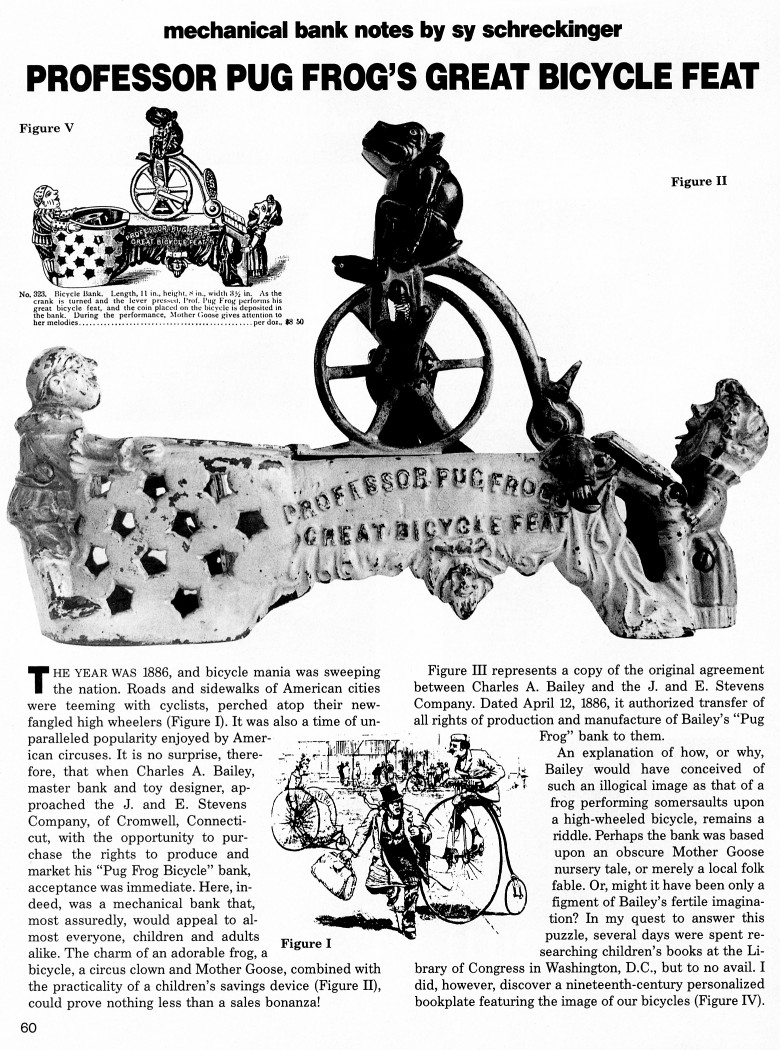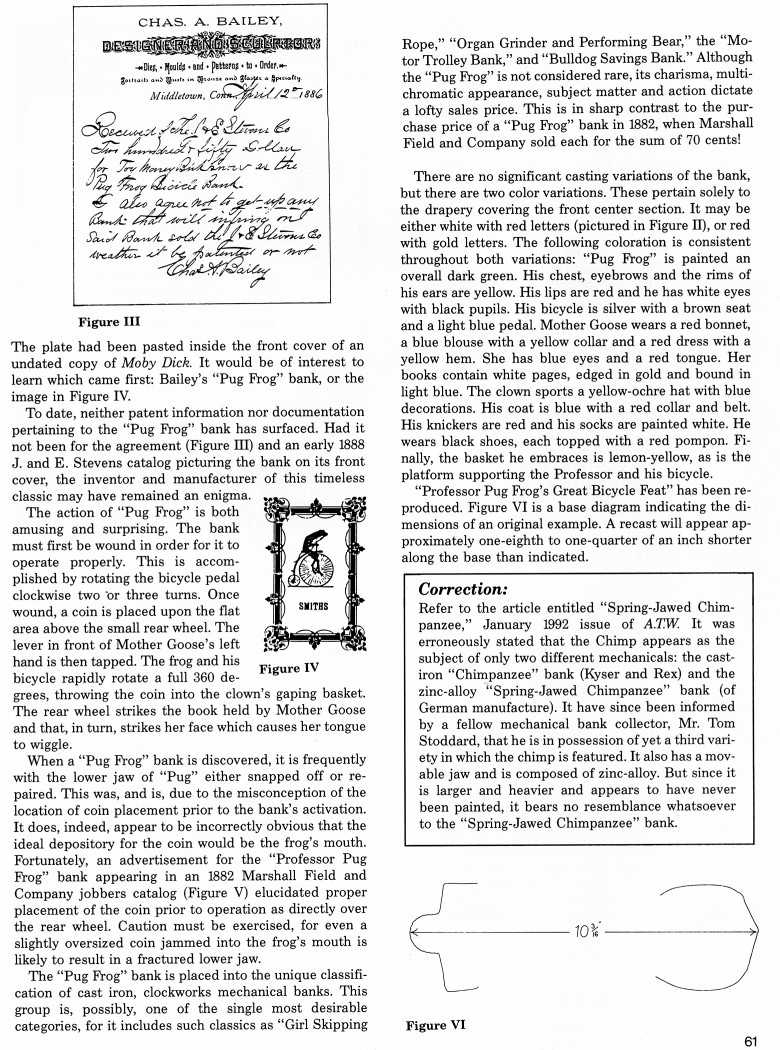|
Professor Pug Frog’s Great Bicycle Feat
by Sy Schreckinger – ANTIQUE TOY WORLD Magazine – May, 1992
The year was 1886, and bicycle mania was
sweeping the nation. Roads and sidewalks of American cities were teeming
with cyclists, perched atop their newfangled high wheelers (Figure I). It
was also a time of unparalleled popularity enjoyed by American circuses.
It is no surprise, therefore, that when Charles A. Bailey, master bank and
toy designer, approached the J. and E. Stevens Company, of Cromwell,
Connecticut, with the opportunity to purchase the rights to produce and
market his "Pug Frog Bicycle" bank, acceptance was immediate. Here,
indeed, was a mechanical bank that, most assuredly, would appeal to almost
everyone, children and adults alike. The charm of an adorable frog, a
bicycle, a circus clown and Mother Goose, combined with the practicality
of a children's savings device (Figure II), could prove nothing less than
a sales bonanza!
Figure III represents a copy of the original agreement between
Charles A. Bailey and the J. and E. Stevens Company. Dated April 12, 1886,
it authorized transfer of all rights of production and manufacture of
Bailey's "Pug Frog" bank to them.
An explanation of how, or why, Bailey would have conceived of such an
illogical image as that of a frog performing somersaults upon a
high-wheeled bicycle, remains a riddle. Perhaps the bank was based upon an
obscure Mother Goose nursery tale, or merely a local folk fable. Or, might
it have been only a figment of Bailey's fertile imagination? In my quest
to answer this puzzle, several days were spent researching children's
books at the Library of Congress in Washington, D.C., but to no avail. I
did, however, discover a nineteenth-century personalized bookplate
featuring the image of our bicycles (Figure IV). The plate had been pasted
inside the front cover of an undated copy of Moby Dick. It would be of
interest to learn which came first: Bailey's "Pug Frog" bank, or the image
in Figure IV.
To date, neither patent information nor documentation pertaining to
the "Pug Frog" bank has surfaced. Had it not been for the agreement
(Figure III) and an early 1888 J. and E. Stevens catalog picturing the
bank on its front cover, the inventor and manufacturer of this timeless
classic may have remained an enigma. The action of "Pug Frog" is both
amusing and surprising. The bank must first be wound in order for it to
operate properly. This is accomplished by rotating the bicycle pedal
clockwise two or three turns. Once wound, a coin is placed upon the flat
area above the small rear wheel. The lever in front of Mother Goose's left
hand is then tapped. The frog and his bicycle rapidly rotate a full 360
degrees, throwing the coin into the clown's gaping basket. The rear wheel
strikes the book held by Mother Goose and that, in turn, strikes her face
which causes her tongue to wiggle.
When a "Pug Frog" bank is discovered, it is frequently with the lower
jaw of "Pug" either snapped off or repaired. This was, and is, due to the
misconception of the location of coin placement prior to the bank's
activation. It does, indeed, appear to be incorrectly obvious that the
ideal depository for the coin would be the frog's mouth. Fortunately, an
advertisement for the "Professor Pug Frog" bank appearing in an 1882
Marshall Field and Company jobbers catalog (Figure V) elucidated proper
placement of the coin prior to operation as directly over the rear wheel.
Caution must be exercised, for even a slightly oversized coin jammed into
the frog's mouth is likely to result in a fractured lower jaw.
The "Pug Frog" bank is placed into the unique classification of cast
iron, clockworks mechanical banks. This group is, possibly, one of the
single most desirable categories, for it includes such classics as "Girl
Skipping Rope," "Organ Grinder and Performing Bear," the "Motor Trolley
Bank," and "Bulldog Savings Bank." Although the "Pug Frog" is not
considered rare, its charisma, multi-chromatic appearance, subject matter
and action dictate a lofty sales price. This is in sharp contrast to the
purchase price of a "Pug Frog" bank in 1882, when Marshall Field and
Company sold each for the sum of 70 cents!
There are no significant casting variations of the bank, but there
are two color variations. These pertain solely to the drapery covering the
front center section. It may be either white with red letters (pictured in
Figure II), or red with gold letters. The following coloration is
consistent throughout both variations: "Pug Frog" is painted an overall
dark green. His chest, eyebrows and the rims of his ears are yellow. His
lips are red and he has white eyes with black pupils. His bicycle is
silver with a brown seat and a light blue pedal. Mother Goose wears a red
bonnet, a blue blouse with a yellow collar and a red dress with a yellow
hem. She has blue eyes and a red tongue. Her books contain white pages,
edged in gold and bound in light blue. The clown sports a yellow-ochre hat
with blue decorations. His coat is blue with a red collar and belt. His
knickers are red and his socks are painted white. He wears black shoes,
each topped with a red pompon. Finally, the basket he embraces is
lemon-yellow, as is the platform supporting the Professor and his bicycle.
"Professor Pug Frog's Great Bicycle Feat" has been reproduced.
Figure VI is a base diagram indicating the dimensions of an original
example. A recast will appear approximately one-eighth to one-quarter of
an inch shorter along the base than indicated.
Correction: Refer to the article entitled "Spring-Jawed Chimpanzee,"
January
1992 issue of A.T.W. It was erroneously stated that the Chimp appears as
the subject of only two different mechanicals: the cast-iron "Chimpanzee"
bank (Kyser and Rex) and the zinc-alloy "Spring-Jawed Chimpanzee" bank (of
German manufacture). It have since been informed by a fellow mechanical
bank collector, Mr. Tom Stoddard, that he is in possession of yet a third
variety in which the chimp is featured. It also has a movable jaw and is
composed of zinc-alloy. But since it is larger and heavier and appears to
have never been painted, it bears no resemblance whatsoever to the
"Spring-Jawed Chimpanzee" bank.
|


